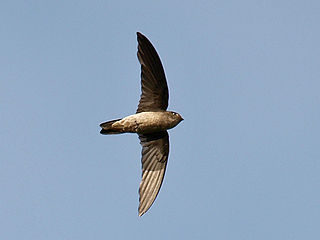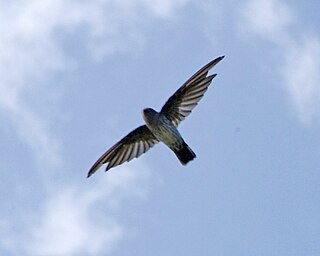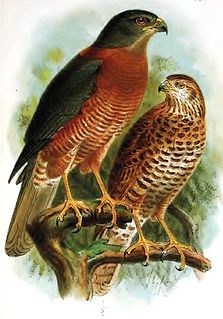
Swiftlets are birds contained within the four genera Aerodramus, Hydrochous, Schoutedenapus and Collocalia. They form the Collocaliini tribe within the swift family Apodidae. The group contains around thirty species mostly confined to southern Asia, south Pacific islands, and northeastern Australia, all within the tropical and subtropical regions. They are in many respects typical members of the Apodidae, having narrow wings for fast flight, with a wide gape and small reduced beak surrounded by bristles for catching insects in flight. What distinguishes many but not all species from other swifts and indeed almost all other birds is their ability to use a simple but effective form of echolocation to navigate in total darkness through the chasms and shafts of the caves where they roost at night and breed. The nests of some species are built entirely from threads of their saliva, and are collected for the famous Chinese delicacy bird's nest soup.

Aerodramus is a genus of small, dark, cave-nesting birds in the Collocaliini tribe of the swift family. Its members are confined to tropical and subtropical regions in southern Asia, Oceania and northeastern Australia. Many of its members were formerly classified in Collocalia, but were first placed in a separate genus by American ornithologist Harry Church Oberholser in 1906.

The Christmas imperial pigeon, Black imperial pigeon, Dusky imperial pigeon, Wharton's imperial pigeon, or burong pergam, is a large imperial pigeon endemic to Christmas Island in the northeastern Indian Ocean. It has an overall grey-blue colouration, and juveniles are duller than adults. It makes a soft purring coo sound and a deeper whoo sound comparable to a cow mooing. It lays one glossy white egg per brood, and is possibly somewhat colonial.

The edible-nest swiftlet, also known as the white-nest swiftlet, is a small bird of the swift family which is found in South-East Asia. Its opaque and whitish bird nest is made exclusively of solidified saliva and is the main ingredient of bird's nest soup, a delicacy of Chinese cuisine.

Collocalia is a genus of swifts, containing some of the smaller species termed "swiftlets". Formerly a catch-all genus for these, a number of its former members are now normally placed in Aerodramus.

The glossy swiftlet is a species of swift in the family Apodidae. It is found on the Indonesian island of Sulawesi and eastwards to New Guinea, the Bismarck Archipelago and the Solomon Islands.
The mountain swiftlet is a species of swift in the family Apodidae. It is endemic to the island of New Guinea and the nearby islands of Karkar, Yapen and Goodenough. It was once placed in the genus Collocalia but has been moved, with many others, to Aerodramus. The species is divided into three subspecies, with the nominate, A. h. hirundinacea ranging over most of New Guinea, the subspecies A. h. excelsus occurring over 1600 m in the Snow Mountains and Cartenz peaks of Irian Jaya and A. h. baru being restricted to Yapen Island. It occurs in alpine areas from 500 m to the treeline. Its natural habitat is tropical moist montane forests and other mountainous habitats in New Guinea. It also occurs in lower numbers in the lowlands near hills.

The cave swiftlet is a species of swift in the family Apodidae. It is found on the Indonesia islands of Sumatra, Java and Bali. It is a woodland species and nests in caves. The Bornean swiftlet was considered a subspecies, but is now usually considered distinct.

The Christmas boobook, also known more specifically as the Christmas Island hawk-owl, is a species of owl in the family Strigidae.

The Christmas goshawk or Christmas Island goshawk, is a bird of prey in the goshawk and sparrowhawk family Accipitridae. It is a threatened endemic of Christmas Island, an Australian territory in the eastern Indian Ocean.

The Christmas emerald dove, also known as the Christmas green-winged pigeon, is a bird in the pigeon family, Columbidae. It is a distinctive subspecies of the common emerald dove that is endemic to Christmas Island, an Australian territory in the eastern Indian Ocean.
The Bornean swiftlet, also referred to as the Kinabalu 'linchi' swiftlet, is a small bird in the swift family Apodidae. It is endemic to the northern mountains of the island of Borneo. It has variously been considered a subspecies of the glossy swiftlet or the cave swiftlet, and in 2008 was split from the latter as a full species C. dodgei.

The grey-rumped swiftlet or grey-rumped swiftlet, is a small bird in the swift family Apodidae. It is endemic to some islands in the Philippines.

The Apodinae are a subfamily of swifts and contain the following species:
The satin swiftlet is a small bird in the swift family Apodidae. It is endemic to the Santa Cruz Islands, Vanuatu, New Caledonia and the Loyalty Islands in the southwestern Pacific Ocean. It was formerly treated as a subspecies of the glossy swiftlet.
The drab swiftlet is a small bird in the swift family Apodidae. It is endemic to the Lesser Sunda Islands in Indonesia. It was formerly treated as a subspecies of the glossy swiftlet.

The plume-toed swiftlet is a small bird in the swift family Apodidae. It is found on some eastern Indian Ocean islands, the Malay Peninsula, Sumatra, and lowland Borneo.

The ridgetop swiftlet is a small bird in the swift family Apodidae. It is endemic to the Philippines.
The Tenggara swiftlet is a small bird in the swift family Apodidae. It is endemic to the western Lesser Sunda Islands of Indonesia.













